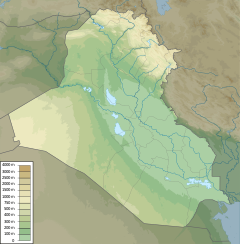
Back أسطوانة رسام Arabic Cilindro Rassam Spanish Cilindro Rassam Italian Rassam-cilinder Dutch Rasamov valj Slovenian
| Rassam cylinder | |
|---|---|
 Rassam cylinder of Ashurbanipal. A 10-sided prism and the most complete of the chronicles of Ashurbanipal. Nineveh, 643 BCE. British Museum.[1] | |
| Created | 643 BCE |
| Discovered | Nineveh 36°21′34″N 43°09′10″E / 36.359444°N 43.152778°E |
| Present location | British Museum, London |
| Registration | BM 91026 |

"Assurbanipal King of Assyria"
an-szar2-du3-a man kur_ an-szar2{ki}
in the Rassam cylinder, 643 BCE.[2]
an-szar2-du3-a man kur_ an-szar2{ki}
in the Rassam cylinder, 643 BCE.[2]

The Rassam cylinder is a cuneiform cylinder, forming a prism with ten faces, written by Neo-Assyrian king Ashurbanipal in 643 BCE. The 7th century BCE cylinder was discovered in the North Palace of Nineveh by Hormuzd Rassam in 1854, hence its name. It is located in the British Museum.[4][1]
- ^ a b "Rassam cylinder British Museum". The British Museum.
- ^ For the original inscription: Rawlinson, H.C. Cuneiform inscriptions of Western Asia (PDF). p. 3, column 2, line 98. For the transliteration: "CDLI-Archival View". cdli.ucla.edu. For the translation: Luckenbill, David. Ancient Records of Assyria and Babylonia Volume II (PDF). p. 297.
- ^ "Wall panel; relief British Museum". The British Museum.
- ^ Cite error: The named reference
DDLwas invoked but never defined (see the help page).
© MMXXIII Rich X Search. We shall prevail. All rights reserved. Rich X Search

